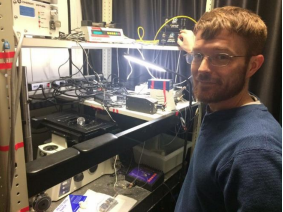July 25, 2017 – J. Brooks Crickard, Ph.D. was named to the Damon Runyon Cancer Research Foundation’s Top Young Scientist List in a report from the Foundation on July 14, 2017. The Damon Runyon Cancer Research Foundation, a non-profit organization focused on supporting innovative early career researchers, named Crickard as one of the 18 new Damon Runyon Fellows at its spring Fellowship Award Committee review. The recipients of this prestigious, four-year award are outstanding postdoctoral scientists conducting basic and translational cancer research in the laboratories of leading senior investigators across the country. The Fellowship encourages the nation’s most promising young scientists to pursue careers in cancer research by providing them with independent funding ($231,000 each) to work on innovative projects that have the potential to impact cancer prevention, diagnosis, and treatment.
Crickard is an Alumni of Penn State’s Biochemistry, Microbiology and Molecular Biology Graduate Program and worked in the laboratory of Dr. Joseph Reese, Ph. D. from 2011 – 2016. Crickard is currently pursuing his postdoctoral fellowship at Columbia University in New York focusing his research in the area of biochemistry.
Along with his sponsor at Columbia University, Eric C. Greene, Ph.D., Crickard is using high-throughput single molecule imaging to rebuild and visualize the process of homologous recombination (HR) in real time. DNA is subjected to many insults leading to damage. This DNA damage leads to a loss in genomic integrity, resulting in the formation and metastasis of many types of cancer. To guard against DNA damage, cells have developed several complex regulatory networks devoted to repair of damaged DNA, including HR. HR involves the search and pairing of one damaged piece of DNA to similar or identical DNA sequences to promote repair of the damaged piece, thus maintaining genome integrity. He seeks to understand, at the most basic biochemical level, how two of the key protein components in HR, Rad51 and Rad54, function to find and repair damaged DNA. His findings will give new insights into how cells fix damaged DNA, which may be key to the development of novel treatments and therapeutic options for all types of cancer.

